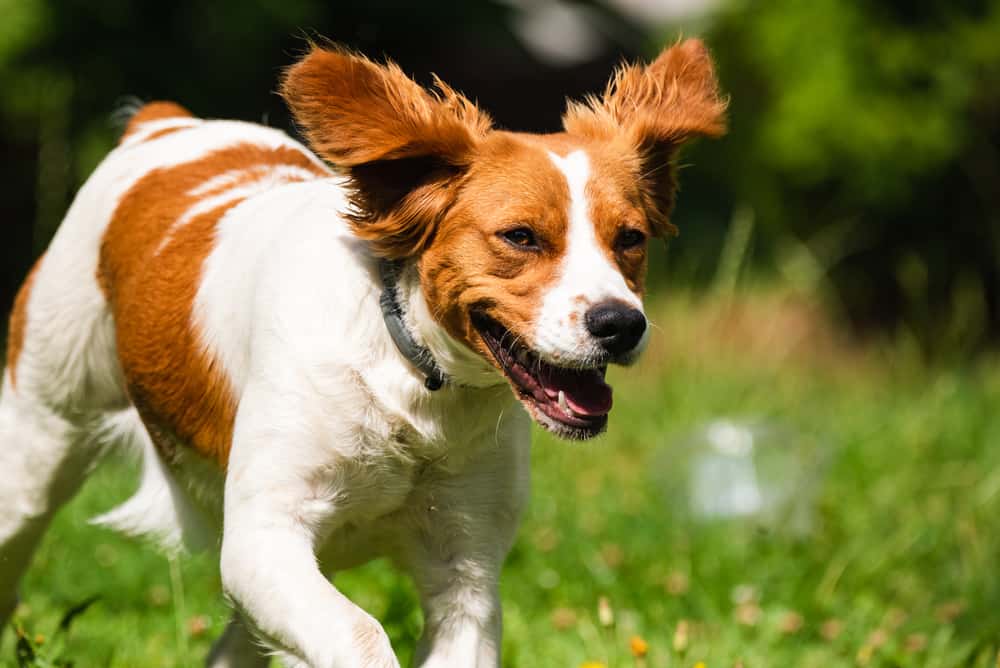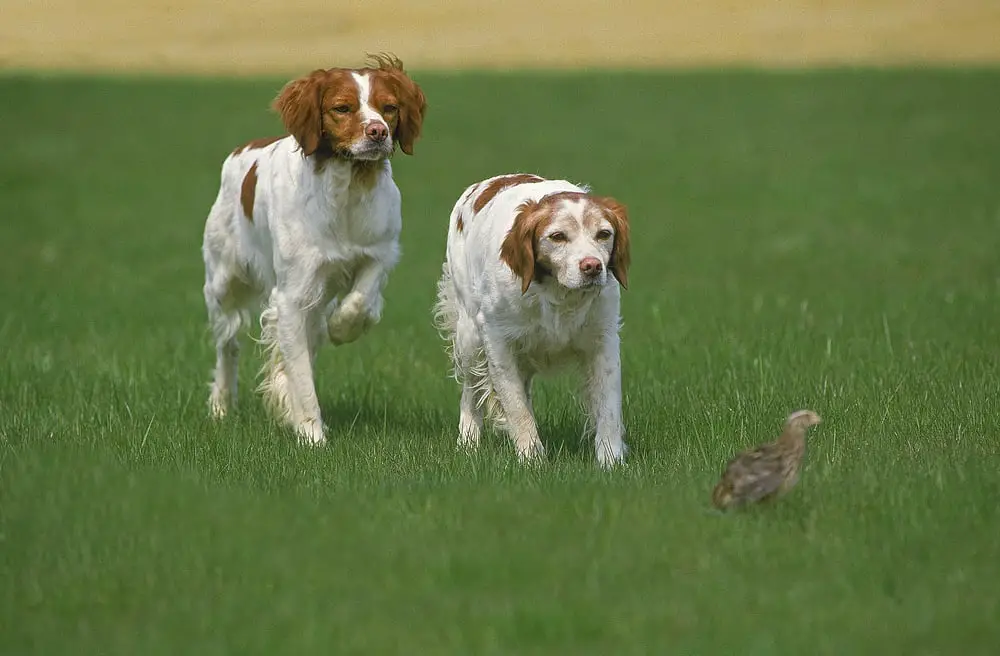Complete Guide To The Brittany: Care, Health, Feeding and More
Bred in the finest hunting tradition, the Brittany is a versatile outdoorsy dog. Enthusiastic for adventure, they’re renowned hunting partners and energetic family companions.
There are quite a few Brittanys that come into my veterinary practice. I’ve seen many, many of this breed over my 20+ years of practice and I’m happy to share the knowledge I’ve gained about them with you.
Table of Contents
How Big Does The Brittany Get?
| Height | Weight | |
| Male | 17.5″ – 20.5″ at the shoulder | 30-40 lbs |
| Female | 17.5″ – 20.5″ at the shoulder | 30-40 lbs |
What Do Brittanys Look Like?
Brittanys resemble both spaniels and pointers. They’re closer in size to spaniels but with the pointer’s longer legs. Their soft, mid-length coats are flat or wavy with moderate feathers.
Colors include vibrant shades of:
• Liver and White
• Liver Roan
• White and Liver
• Liver, White and Orange
• White and Orange
• Orange Roan and more

The Brittany’s muzzle is compact but not short — ears fall to the jawline. Eyes range in color from amber to deep brown but dark is preferable for show.
Known for their distinctive colors, Brittanys are easy to identify among similar dogs with practice. But those unfamiliar with the breed may mistake them for the German Shorthaired Pointer or Welsh Springer Spaniel.
What Is The Personality Of A Brittany?
Unusual for a hunting dog, the Brittany has a buoyant personality. When they’re tracking, they mean business, but when they’re with family, they’re loyal, outgoing and affectionate.
Brittanys were born for the outdoors and need lots of fresh air and exercise. The prefer a country environment but will thrive in the city with active owners. Running and canine sports are favorite activities — they’re top finishers in agility, field and dock-diving competitions.
Highly intelligent, Brittanys are trainable and eager to please. Excellent with children, they’re a rare breed for which exercise and basic training are the only prerequisites for good manners.
How Much Grooming Do Brittanys Need?
Brittanys are remarkably easy to groom. Their dense coats are neither silky nor wiry and seem to naturally resist soiling.
Twice weekly brushing with a soft-bristled brush or hound glove removes outdoor debris, distributes skin oils and restores a lustrous shine. Use a steel comb to tease tangles from long feathers. Trimming the tail and legs is good preventive maintenance for dogs that hunt in high grass or areas with sticky burdocks.

Bathing is required only when the coat is visibly soiled or to get rid of doggy smell. Brittanys are a clean breed, but hunters get wet retrieving fowl, and the dampness contributes to unpleasant odors. Long ears can similarly trap moisture, so check them weekly for signs of irritation — a musty odor could indicate a yeast infection.
The Brittanys well-arched toes offer traction when they’re running, but the angle at which their nails grow leave them vulnerable to discomfort if they’re not kept short. Monthly trimming with nail trimmers or a rotary tool removes the excess and smooths rough ends that could snag on rocks or bushes.
How Much Exercise Do Brittanys Need?
A lot. This is a dog bred to run all day and not get tired. This is the perfect dog for an active family or individual who will take them for a long walk every day as well as playing ball, hiking, going to the dog park, etc.
I’ve seen a few Brittanys who have been nervous and anxious owned by families who don’t exercise these dogs the way they need to. Please do not get this dog unless you are ready to exercise it as much as it needs. Otherwise you are not giving the Brittany the quality of life that it needs.

What Kind Of Dog Food Is Best For Brittanys?
Before we start with the food lists, just know that grain-free dog foods are a myth. There’s zero science showing that they are helpful. In fact, there’s increasing evidence that it’s causing issues in certain breeds of dogs. Food allergies are the only reason to even consider a grain-free diet but only choose one with the help of your veterinarian.
Best Puppy Food For The Brittany:
Best Adult Food For The Brittany:
If your particular Brittany has a high motor and has a hard time keeping weight on, you might consider keeping them on puppy food until they get to a point where you start seeing them actually maintain a healthy weight. A hunting or highly active Brittany will always appear really thin but this is just how they are when heavily exercised.
How Long Do Brittanys Live?
12-14 years
What Health Problems Do Brittanys Have?
Brittanys are a healthy breed of dog but I have seen them develop a few issues:
- Hip Dysplasia
- Dental Disease
- Obesity for the lower-motor dogs that don’t get a lot of exercise and are fed too much
- Anxiety for the high-motor Brittanys who aren’t exercised enough
Going through a good Breeder to not only get a high-quality dog but to also be pointed to the puppy that matches your lifestyle would be the best way to ensure a long, healthy life with your Brittany.
Where Can I Learn More About Brittanys?
Check out this large list of regional Brittany Clubs located throughout the United States
Where Can I Find A Brittany?
I would recommend you start with your local Brittany Club on the list just above this line. Finding a good, local breeder who can guide you to the puppy that would be right for you is essential.
You can also check out the AKC puppy page.
Looking for a Rescue? The American Brittany Rescue is the place to start.
Interesting Facts About the Brittany
Brittanys have a long and certain history.
Did you know?
• The Breed is Distinctly European
Brittanys are immortalized in 17th -century European art from French, Dutch and Flemish masters. Popular among the medieval peasantry for their versatility, they were bred for their ability to hunt virtually any fowl. Named for the region of France from which they originated, they’re considered to be of European origin.
• Are They Brittanys or Brittany Spaniels?
Brittanys came to the United States in the early 1930s — by 1934, they were recognized by the AKC as Brittany Spaniels. Different breeding techniques, however, caused the American and European lines to diverge. Their name was officially changed to Brittany in 1982, but they’re still known as Brittany Spaniels in Europe.
• The Plural Breaks the Rules
According to the Miriam-Webster Dictionary, the plural of Brittany can be Brittanies or Brittanys, breaking the usual rules. Kennel clubs agree, however, that Brittanys is the preferred plural.
• Adaptable is Their Middle Name
Not only are Brittanys capable hunters, but they also excel at canine sports and almost anything else they set their mind to. Hunters focus on their talent in the field, but others harness the same strengths to breed champion sports stars and show dogs.
• They’re Not the Best Service Dogs
Brittanys have a heart of gold, but they’re too energetic and distractible to be dependable service dogs. Obedience training makes excellent hunters and polite companions, but they’re too active and independent to be trusted with an individual’s every need.
• Most Are Born with Short Tails
The AKC standard calls for docked tails of four inches or less, but most Brittanys will save you the trouble by being born with little or no tail. Though the practice is controversial and banned in some countries, most hunters believe docking long tails and removing rear dewclaws after birth is safer for the dog.
• American And European Breed Standards Vary
It’s not unusual for the AKC and European Dog Clubs to have different breed standards. The most significant difference with the Brittany is color. Black markings, for example, are a disqualification in the United States but accepted in Europe.
• They’re Champions!
Brittanys have won more dual championships in conformation and field competitions than any other sporting dog. Three have won top honors among the sporting group, yet none have ever taken Westminster’s prestigious Best in Show title. Still, they’re the AKC’s 30th most popular dog, proving they’re winners in our hearts.
